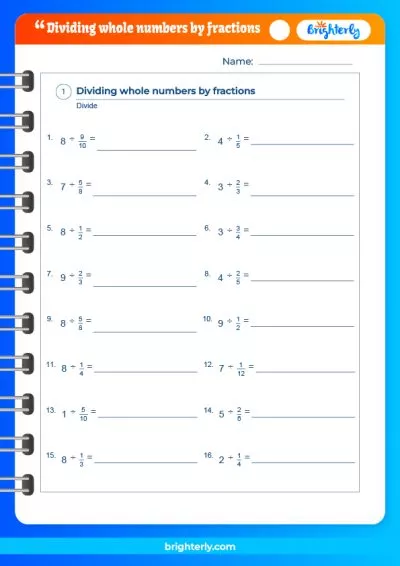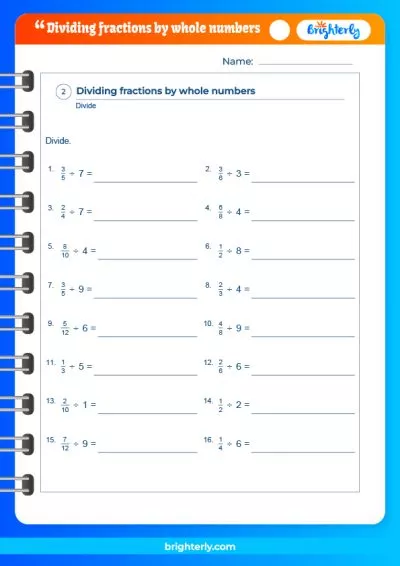Unit Fraction – Definition With Examples
Updated on January 15, 2024
Welcome to Brighterly, a fun and interactive platform for children to learn and explore the wonderful world of mathematics. Today, we’ll be diving into the fascinating world of unit fractions. Unit fractions are a fundamental building block of the mathematics, and learning about them will help you gain a deeper understanding of more complex math concepts. So, let’s get started!
What is a Unit Fraction?
A unit fraction is a special type of fraction where the numerator (the number on top) is always 1, and the denominator (the number on the bottom) is a positive integer. In other words, unit fractions represent the parts of a whole, where the whole is divided into equal parts. Examples of unit fractions include 1/2, 1/3, 1/4, and so on.
Unit fractions are essential in mathematics because they provide the foundation for understanding more advanced concepts like decimal and percentage representation of numbers.
If you’re looking to improve your understanding of Unit Fractions, you may find it helpful to explore the range of math worksheets offered by Brighterly. These worksheets have been specifically designed to aid in learning and strengthening your grasp of this topic.
Difference Between Unit and Non-unit Fraction
There are two main types of fractions: unit fractions and non-unit fractions. As we mentioned earlier, a unit fraction has a numerator of 1 and a denominator that is a positive integer. Examples include 1/2, 1/3, and 1/5.
On the other hand, a non-unit fraction has a numerator other than 1, and the denominator is still a positive integer. Examples of non-unit fractions include 2/3, 5/6, and 7/8.
Understanding the difference between unit and non-unit fractions is important for grasping more complex fraction concepts and operations, such as addition, subtraction, multiplication, and division of fractions.
How to Multiply Unit Fractions
Multiplying unit fractions is quite simple. To multiply two unit fractions, you simply multiply their denominators. Here’s an example:
1/3 × 1/4 = (1 × 1) / (3 × 4) = 1/12
As you can see, when you multiply two unit fractions, you end up with another unit fraction. This is a general property of unit fractions.
Unit Fraction Divided by Whole Number
Dividing a unit fraction by a whole number involves a simple process as well. To divide a unit fraction by a whole number, you multiply the unit fraction by the reciprocal of the whole number. Here’s an example:
1/3 ÷ 2 = 1/3 × 1/2 = (1 × 1) / (3 × 2) = 1/6
In this case, the division of the unit fraction by a whole number results in another unit fraction.
How to Add Unit Fractions
With the Same Denominators
Adding unit fractions with the same denominators is a straightforward process. Simply add the numerators and keep the denominator the same. For example:
1/4 + 1/4 = (1 + 1) / 4 = 2/4 = 1/2
With Different Denominators
When adding unit fractions with different denominators, you’ll first need to find a common denominator. To do this, find the least common multiple (LCM) of the two denominators. Then, convert each fraction to an equivalent fraction with the common denominator and add the numerators. For example:
1/3 + 1/4 = 1/12 + 3/12 = 4/12 = 1/3
How to Subtract Unit Fractions
Subtracting unit fractions follows a similar process to addition.
With the Same Denominators
To subtract unit fractions with the same denominators, simply subtract the numerators and keep the denominator the same. For example:
3/4 – 1/4 = (3 – 1) / 4 = 2/4 = 1/2
With Different Denominators
When subtracting unit fractions with different denominators, you’ll first need to find a common denominator, just like in addition. Once you have the common denominator, convert each fraction to an equivalent fraction with the common denominator and subtract the numerators. For example:
1/3 – 1/6 = 2/6 – 1/6 = 1/6
Unit Fractions Examples
Here are some examples of unit fractions and their operations:
- Addition: 1/4 + 1/4 = 1/2
- Subtraction: 1/2 – 1/4 = 1/4
- Multiplication: 1/3 × 1/5 = 1/15
- Division: 1/6 ÷ 3 = 1/18
Unit Fraction Practice Questions
- Multiply: 1/5 × 1/7
- Divide: 1/8 ÷ 4
- Add: 1/3 + 1/5
- Subtract: 1/2 – 1/6
Conclusion
In conclusion, grasping the concept of unit fractions is indispensable for establishing a robust foundation in mathematics. They play a pivotal role in unlocking the door to more intricate concepts, such as decimals, percentages, and ratios. With a thorough understanding of unit fractions, you’ll find it much easier to tackle complex mathematical problems and even excel in other areas of math, such as algebra and geometry.
At Brighterly, we’re dedicated to providing a stimulating and engaging learning environment to foster a genuine love for mathematics in young minds. We believe that through interactive learning and practical applications, children can unlock their full potential and excel in their mathematical pursuits. We hope this comprehensive article has shed light on the concept of unit fractions and their operations, and that it has inspired you to explore further into the fascinating world of mathematics.
Remember, the journey to becoming a math whiz starts with a single step, and mastering unit fractions is a monumental stride in the right direction. Keep practicing, stay curious, and continue to challenge yourself – and as always, remember that the Brighterly team is here to guide you every step of the way!
Frequently Asked Questions on Unit Fraction
What is a unit fraction?
A unit fraction is a specific type of fraction where the numerator (the top number) is always 1, and the denominator (the bottom number) is a positive integer. In essence, unit fractions represent parts of a whole, where the whole is divided into equal parts. Examples of unit fractions include 1/2, 1/3, 1/4, 1/5, and so on. Unit fractions are fundamental in mathematics because they form the basis for understanding more advanced concepts like decimals, percentages, and ratios.
How do you multiply unit fractions?
To multiply unit fractions, you simply multiply their denominators (the bottom numbers). The numerator of the product will always be 1, which ensures that the result is also a unit fraction. Here’s an example:
1/3 × 1/5 = (1 × 1) / (3 × 5) = 1/15
In this case, when you multiply two unit fractions (1/3 and 1/5), you end up with another unit fraction (1/15).
How do you divide a unit fraction by a whole number?
To divide a unit fraction by a whole number, you multiply the unit fraction by the reciprocal of the whole number. The reciprocal of a whole number is found by taking the fraction with 1 as the numerator and the whole number as the denominator. Here’s an example:
1/4 ÷ 3 = 1/4 × 1/3 = (1 × 1) / (4 × 3) = 1/12
In this case, dividing the unit fraction 1/4 by the whole number 3 results in another unit fraction, 1/12.
How do you add and subtract unit fractions?
To add or subtract unit fractions, follow these steps:
a. Find a common denominator: To add or subtract unit fractions, you first need to find a common denominator, which is the least common multiple (LCM) of the two denominators.
b. Convert the fractions: Once you have the common denominator, convert each unit fraction to an equivalent fraction with the common denominator. To do this, multiply the numerator and denominator of each fraction by the factor that was used to find the LCM.
c. Add or subtract the numerators: With the fractions now having the same denominator, you can add or subtract the numerators, keeping the denominator the same.
d. Simplify the result, if possible: If the resulting fraction can be simplified further, do so by dividing both the numerator and the denominator by their greatest common divisor (GCD).
Here’s an example of addition:
1/3 + 1/5 = 1/15 + 3/15 = 4/15
And here’s an example of subtraction:
1/4 – 1/8 = 2/8 – 1/8 = 1/8






